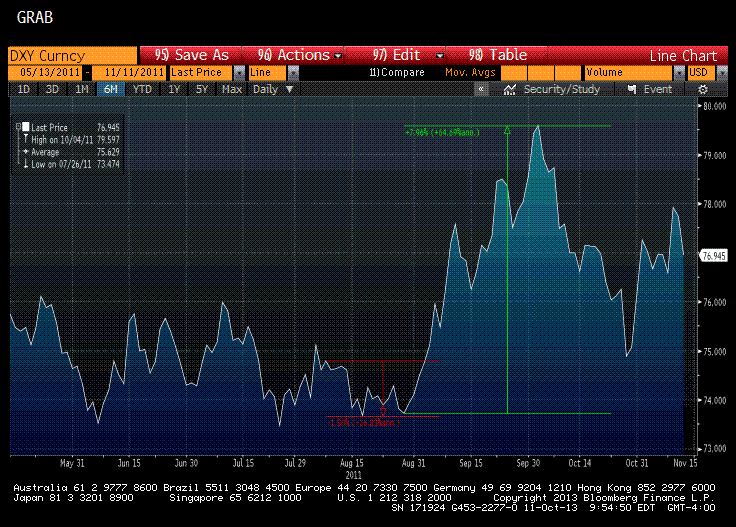US Default would be Temporary
It is important to understand that if the U.S. defaults on its obligations, it would be a temporary technical default. To resolve the situation, politicians just need to put their differences aside and agree to raise the debt ceiling and eventually they will. Yet the historical significance of a default would not be lost amongst investors who would sell U.S. assets as soon as the headline hits the wire and then again when rating agencies put the country's sovereign debt rating on selective or restricted default.However we do not expect an all out collapse in the U.S. dollar and Treasuries because the main buyers of Treasuries are central banks who are less sensitive short term changes in the U.S. fiscal outlook. Also we don't expect an immediate liquidation out of money market funds. The Treasury market is still the largest market in the world and these central banks realize that a massive exodus out of Treasuries would cause U.S. bond yields to spike, leading to spillover affects into their own markets. Technical defaults are not new especially for emerging market nations such as Peru and during the time they fell into default, the country's sovereign debt rating was cut 1 notch and then restored back to prior levels immediately after the payment was made. If the U.S. were to miss a coupon payment or two, we expect any U.S. rating changes to be restored once the payments are made.
Dollar Weakness Should be Limited to 3% Max
Standard and Poor's decision to downgrade the U.S.' sovereign debt rating for the first time ever in 2011 is also a relevant parallel. The announcement was made on August 5th, 2011, a few days after Congress voted to raise the debt ceiling. Almost immediately investors sold dollars but as shown in the chart below, the Dollar Index dropped only 1.5%. The currency then consolidated near its lows for a few weeks before rising nearly 8% over the next 2 months. Losses in USD/JPY were a bit steeper (slightly more than 2%) and the price action was choppier but the EUR/USD traded in a very similar manner as the dollar index, rising only 1.5% before dropping more than 9% in the 2 months that followed. Once the initial shock faded, investors realized that there were few alternatives to U.S. Treasuries. So while we expect the dollar to sell-off if the U.S. defaulted on its debt, we do not expect a massive exodus or a 10% collapse in the dollar.
With all of this in mind, the U.S. government still options to avoid default. October 17th is the date that the Treasury says the U.S. government will run out of cash but there is a short grace period beyond that so a default is not automatic once this date is reached. The President could invoke authority under the 14th Amendment and order the federal government to keep borrowing. Emergency times call for emergency measures and this was a strategy proposed previously by President Clinton during the budget showdown in 2011. The U.S. government could also sell other assets such as gold or prioritize payment of bondholders over other obligations. While the Treasury said they do not have this capacity, rating agencies believe otherwise but prioritization in principle is not a sustainable solution. Eventually we expect one party to concede on the Affordable Care Act, paving the way for an increase in the debt ceiling and when that occurs, we expect the dollar to rise strongly.
Recommended Content
Editors’ Picks
EUR/USD clings to daily gains above 1.0650

EUR/USD gained traction and turned positive on the day above 1.0650. The improvement seen in risk mood following the earlier flight to safety weighs on the US Dollar ahead of the weekend and helps the pair push higher.
GBP/USD recovers toward 1.2450 after UK Retail Sales data

GBP/USD reversed its direction and advanced to the 1.2450 area after touching a fresh multi-month low below 1.2400 in the Asian session. The positive shift seen in risk mood on easing fears over a deepening Iran-Israel conflict supports the pair.
Gold holds steady at around $2,380 following earlier spike

Gold stabilized near $2,380 after spiking above $2,400 with the immediate reaction to reports of Israel striking Iran. Meanwhile, the pullback seen in the US Treasury bond yields helps XAU/USD hold its ground.
Bitcoin Weekly Forecast: BTC post-halving rally could be partially priced in Premium

Bitcoin price shows no signs of directional bias while it holds above $60,000. The fourth BTC halving is partially priced in, according to Deutsche Bank’s research.
Week ahead – US GDP and BoJ decision on top of next week’s agenda

US GDP, core PCE and PMIs the next tests for the Dollar. Investors await BoJ for guidance about next rate hike. EU and UK PMIs, as well as Australian CPIs also on tap.